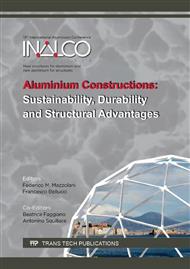p.47
p.53
p.59
p.65
p.71
p.77
p.83
p.91
p.97
Aluminium Machining Chips Formation, Treatment & Recycling: A Review
Abstract:
The recycling of alumium alloys has been growing in interest and applications during the last fourthy years and has become a cost effective, ecological and reliable way to produce aluminium parts. The aluminium scraps that can be recycled include cans and machining chips. The machining processes produce chips of various sizes and shapes, wet or dry, oxidised or not, depending on type of process and the machining conditions, parameters and tools used. Some processes produce metallic dusts and fine chips while other produce large or medium size chips. In some industries such as mould making and aeronautic industries, the chip removal can easily represent 80% of the initial workpiece mass. The type of chips produced during machining can have a great impact on chip management, on part quality, on machine and tool reliability and on part manufacturing costs. The machining chips can be recycled using casting, sintering or pressing and extrusion processes depending on the goal targeted. The selection of the recycling process must take into account the targeted applications, the chip (composition, sizes and cleanliness) and its mechanical properties. Depending on the nature of process to be used and the machining chip generation conditions, some treatments might be necessary prior to transportation and recycling. Parts made with recycled chips can either be bi-phase metal matrix composites materials or usual one phase material with mechanical properties and wear properties comparable or not to the parent alloys. Over the last decades, several chip recycling processes have been proposed for aluminium alloys. This article review the aluminium chips formation, treatement methods, the recycling processes and their impact on recomposed parts’ performance: strength, ductility, corosion and wear resistances.
Info:
Periodical:
Pages:
71-76
Citation:
Online since:
September 2016
Keywords:
Price:
Сopyright:
© 2016 Trans Tech Publications Ltd. All Rights Reserved
Share:
Citation:


